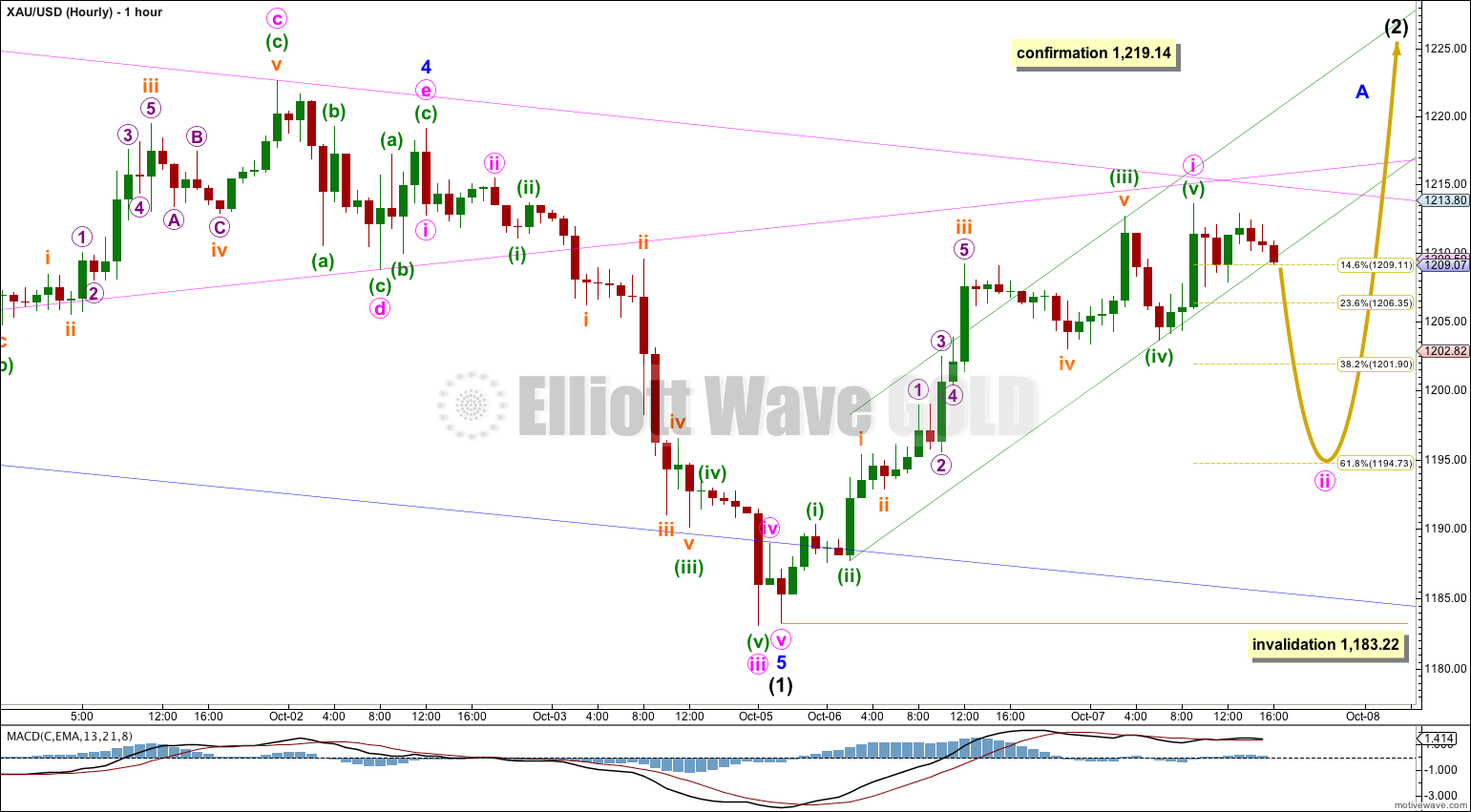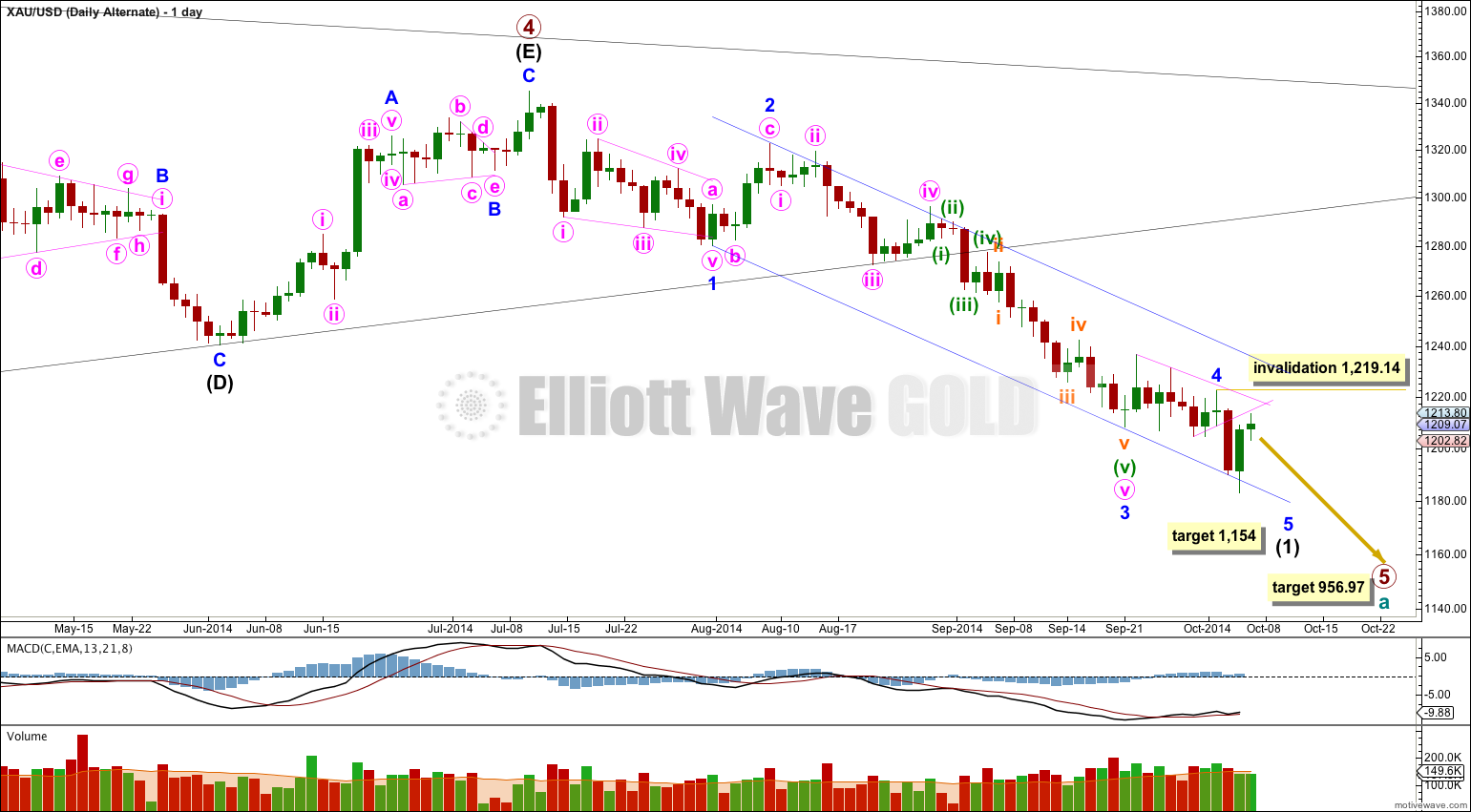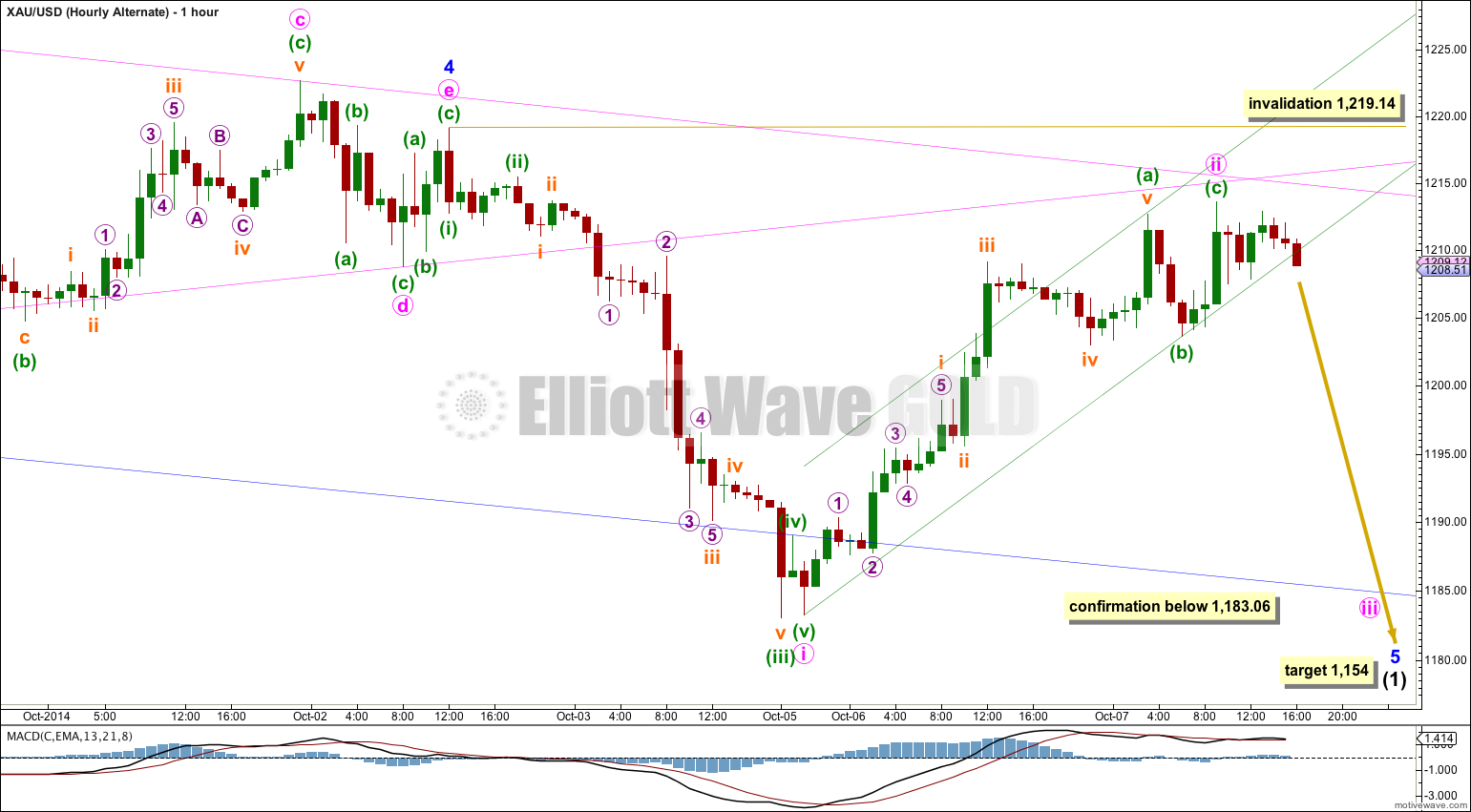Upwards movement was expected for the main Elliott wave count, which is judged to be about 55-60% likely. The alternate Elliott wave count remains valid, but has slightly reduced in probability today.
Summary: Intermediate wave (2) has most likely begun and a new high above 1,219.14 would confirm it. Overall, I expect upwards movement for a few weeks with one downwards or sideways correction along the way for a B wave. In the short term I expect some downwards movement for a second wave correction to end about 1,202 or 1,195.
Click on charts to enlarge.
Main Wave Count
On the weekly chart extend the triangle trend lines of primary wave 4 outwards. The point in time at which they cross over may be the point in time at which primary wave 5 ends. This does not always work, but it works often enough to look out for. It is a rough guideline only and not definitive. A trend line placed from the end of primary wave 4 to the target of primary wave 5 at this point in time shows primary wave 5 would take a total 26 weeks to reach that point, and that is what I will expect. Primary wave 5 is beginning its 13th week.
At 956.97 primary wave 5 would reach equality in length with primary wave 1. Primary wave 3 is $12.54 short of 1.618 the length of primary wave 1, and equality between primary waves 5 and 1 would give a perfect Elliott relationship for this downwards movement.
However, when triangles take their time and move close to the apex of the triangle, as primary wave 4 has (looking at this on a weekly chart is clearer) the movement following the triangle is often shorter and weaker than expected. If the target at 956.97 is wrong it may be too low. In the first instance I expect it is extremely likely that primary wave 5 will move at least below the end of primary wave 3 at 1,180.40 to avoid a truncation. When intermediate waves (1) through to (4) within primary wave 5 are complete I will recalculate the target at intermediate degree because this would have a higher accuracy. I cannot do that yet; I can only calculate it at primary degree.
Movement comfortably below 1,180.84 would provide further confidence in this main wave count as at that stage an alternate idea which sees primary wave 4 as continuing as a barrier triangle would be invalidated.
Draw a channel about intermediate wave (1): draw the first trend line from the lows labeled minor waves 1 to 3, then place a copy on the high labeled minor wave 2. The slight overshoot of the lower edge of this channel indicates minor wave 5 may be over there. Intermediate wave (2) should breach the upper edge of this channel.
Intermediate wave (2) may end close to a Fibonacci ratio of intermediate wave (1). Only because second waves are more commonly deep than shallow is the 0.618 ratio at 1,280.80 slightly favoured. But it does not have to be this deep. When I know where minor waves A and B within this correction have ended then a target should be calculated using the ratio between minor waves A and C.
Intermediate wave (2) is most likely to be a zigzag, but it may also be one of several other possible corrective structures. Due to the large degree the first movement should be a five up. Intermediate wave (2) may not move beyond the start of intermediate wave (1) above 1,345.22.
This is my main wave count for three reasons:
1. Upwards movement from the low looks most like an incomplete impulse. This looks to be too large for a minute degree second wave, and looks more like the start of an intermediate degree correction, which looks incomplete.
2. Fifth waves following fourth wave triangles are often relatively short and brief. I have been caught out before with this, and have learned the hard way that it should be expected as very likely, not just considered as an alternate.
3. Minor wave 5 overshot the lower edge of the blue channel.
Intermediate wave (2) should begin with a five wave structure upwards, which is now complete for minute wave i. This wave count assumes minor wave A will subdivide as a five wave structure, which means intermediate wave (2) would subdivide as a zigzag. Once the first 5-3-5 upwards is complete then an alternate wave count which looks at intermediate wave (2) as a flat or a double must be considered.
Ratios within minute wave i are: there is no Fibonacci ratio between minuette waves (iii) and (i), and minuette wave (v) is 0.43 longer than 0.382 the length of minuette wave (iii).
Ratios within minuette wave (iii) are: there is no Fibonacci ratio between subminuette waves iii and i, and subminuette wave v is 0.42 short of 0.382 the length of subminuette wave iii.
Minute wave ii is most likely to correct to the 0.618 Fibonacci ratio, but it does not have to be that deep. In the first instance I would look for it to end about the 0.382 Fibonacci ratio. It should breach the lower edge of the channel containing minute wave i.
Draw a channel about minute wave i using Elliott’s second technique: draw the first trend line from the lows of minuette waves (ii) to (iv), then place a parallel copy on the high of minuette wave (iii). The middle of the third wave, subminuette wave iii, overshoots the channel which is very typical. When the channel is breached this provides confirmation that minute wave i is over and minute wave ii is underway.
Minute wave ii may not move beyond the start of minute wave i below 1,183.22.
Alternate Wave Count
It is still quite possible that minor wave 5 is incomplete. Upwards movement may be minute wave ii within minor wave 5.
At 1,154 minor wave 5 would reach equality in length with minor wave 1.
Within minor wave 5 minute wave ii may not move beyond the start of minute wave i above 1,219.14.
It is possible to see upwards movement as a completed zigzag. Unfortunately, this movement is not clearly either a five or a three, and can be seen as both. There is no Fibonacci ratio between minuette waves (a) and (c).
The size of minute wave ii in comparison to minute wave i reduces the probability of this alternate wave count. Today I would judge it to have a lower probability, about 40%.
Minute wave iii would reach 1.618 the length of minute wave i close to the target for minor wave 5 to end at 1,154. It may do so, and be followed by a very short fifth wave.
Any further upwards movement for minute wave ii may not move beyond the start of minute wave i above 1,219.14.
If this wave count is correct then a third wave down must begin from here. This should take price below 1,183.06 within the next 24 hours, before next analysis. If it does not do so then this alternate would further reduce in probability.
This analysis is published about 06:15 p.m. EST.




